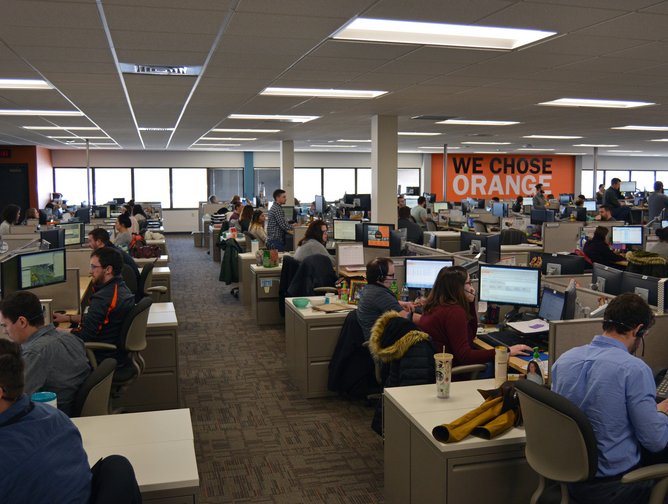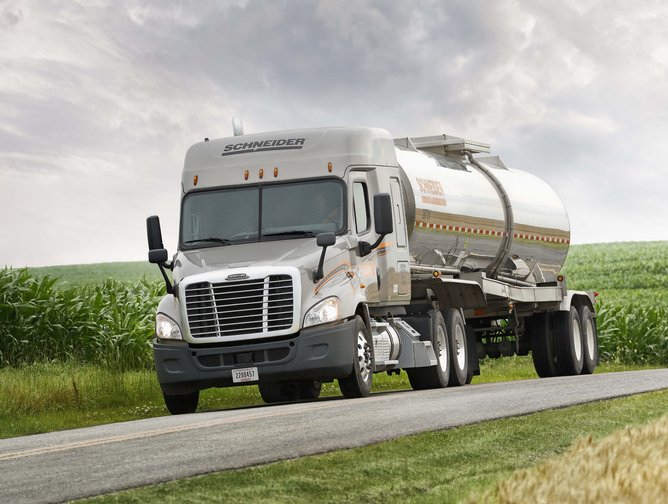How Schneider has delivered unrivalled transportation and logistics services for more than 80 years
Schneider, one of the leading providers of truckload, intermodal and logistics services in North America lives by a promise to deliver for their customers. That promise is increasingly important in a world moving faster than ever, with continually rising expectations on service and partnership.
It is essentially a promise to deliver tomorrow’s world today, and Schneider’s approach to innovation, technology and data science position it well to do just that.
The company plays an integral part in the supply chain of many of the leading names in omnichannel retail, consumer goods, manufacturing and other industries. In order to continuously add value to this ecosystem, Schneider requires a level of technological expertise not often thought of in the transportation industry.
Luckily for Schneider, it has a deep history of innovation and a solid foundation of “pragmatic innovation” driving its success.
That’s what Shaleen Devgun, EVP & CIO of Schneider, feels differentiates the company and enables service like no other.
“Our success as one of the largest truckload, intermodal and logistics services providers in North America lies in our ability to connect and get data from our digital assets,” he says.
“But it doesn’t stop there – it then becomes a question of garnering intelligence from that data by asking what it is telling us and making informed decisions – all in near-real time.”
Schneider has a long history of developing and implementing technology that helped transform the industry. It was one of the first companies to utilize a platform that could track movements of every tractor or trailer back in 1979, implemented satellite technology in the late 80’s, and introduced a self-service track and trace capability in 1997. Furthermore, Schneider evolved from a mainframe to a more modern technical architecture that has helped drive much of the organization’s growth.
Devgun goes as far as saying that Schneider is in fact a technology company masquerading as a trucking company.
“Technology is in our DNA,” says Devgun. “And where we are today, with over 10,000 tractors and over 50,000 trailers and containers – that we see as effectively digital assets – our future depends on leveraging our platform to collect this data, and build on it through analytics, to create insight that we’ve never had before.”
This approach to technology and innovation, with a sharp focus on capturing and utilizing data, is part of a transformational journey that Schneider has been on since 2007. The company worked with Oracle to create a horizontally integrated platform, designed to connect and digitize not only Schneider’s value chain, but also its customer’s.
It’s called the Quest platform, and Schneider uses it to digest all of the information that is coming from its digital assets in the field and create operational insights.
“With Quest we’ve created digitization across our value chain. It connects to every aspect of our business and to our customers, and, more importantly, it connects our customers’ customers to them,” says Devgun.
“Through the Quest platform, we are able to deploy advanced analytics and decision sciences to create and share insights across the most important aspects of our business, which are safety and business performance.”
Technology adoption in transportation has accelerated and Schneider represents a company that disrupts and redefines the art of the possible.
“Where technology may have historically been viewed as a solution to a problem, technology is now creating new business models and opportunities,” says Schneider’s Chief Operating Officer Mark Rourke. “It really reinforces our belief that technology has evolved to a ‘nerve center’ component of our company versus a traditional cost center.”
Devgun couldn’t agree more. “We are witnessing this in full force when it comes to the adoption of social, mobile and contextual technologies,” he says. “Innovation is driving changes and evolutions in the industry that enable non-industry disrupters to come in and challenge the existing models.”
So how does Schneider approach this changing landscape? With the same pragmatic approach that it has had for over 80 years, only in today’s world its very much centred around disrupting traditional models and ways of thinking.
“We will always look at what’s changing and think of how we apply our pragmatic approach to it in a way that produces results for our customers, our drivers and associates, and our business” Devgun says.
“We are constantly striving to drive value for our shareholders, our customers and our driver associates. So, we ask ourselves, ‘how do we create value for each of the actors in our ecosystem through the use of technology?’”
“That’s what drives our strategy. That’s what drives our thinking with technology.”
A key component in any organization is often one that is lost throughout the technology conversation – the people. Technology and solutions are only tools, but it takes the right people with the right skillset to drive efficiencies and deliver on a promise.
Devgun cannot stress enough how important a role driver associates play in the Schneider ecosystem.
“To me, technology is going to help everybody in the organization rise higher in the value chain,” he says. “It's going to take away the transactional, and the commoditized pieces of their job, and make them more valuable.”
This is a sentiment shared by Brian Stuelpner, VP of Strategy, Planning & Architecture.
“When we talk about automation and cognitive intelligence, it’s about augmenting the individual,” he says. “What we are trying to do help is help our people be more effective, so that they can focus on the right things and drive value.”
“This will be key to our success now, and in the future.”
As a company that places its customers and drivers at the very center of what it does, particularly in an ever-evolving space, the importance of understanding how their needs are evolving cannot be understated.
With increasing power in the palm of their hands, the customer of 2018, in any industry, is one that demands instant gratification and is one that is much more in tune with what’s happening behind the scenes.
This effect is what Devgun sees influencing buying behavior and an unparalleled understanding by customers of the nuts and bolts of the supply chain.
“As they demand more information and greater access to that information, what impact does that have on the supply chain?” says Devgun. “Their expectations surrounding visibility have dramatically changed, and we are seeing this more and more in the e-commerce space. Our push into e-commerce with dual first-to-final mile acquisitions in 2016 help highlight our belief that the growth of the e-commerce channel, and the platforms that enable it, are becoming extremely important and must be a focus area for us going forward.”
E-commerce is only one of several examples of how technology is changing and transforming the supply chain industry. Blockchain, automation and cognitive intelligence are all key technology terms that are dominating the innovation conversation, and Devgun recognizes that as more companies embrace technology, they must continue to understand what works, what doesn’t, and more importantly, what will best serve their customers.
“Technology should never be adopted for technology’s sake,” he says. “We can talk about our pragmatic approach to innovation, but the real significance lies in showing how we can create real, tangible value for the actors in our ecosystem.”
Technology has also redefined the idea of competition and how companies can differentiate from one another.
For Stuelpner, in order to continue to succeed in this industry, a company like Schneider must be agile and be willing to take some risks.
“The rate and pace of change is requiring a nimbleness not seen before,” says Stuelpner. “Our success is dependent on our ability to deliver value quickly and use our agility to stay ahead of the market.”
This has seen Schneider push its own capabilities as an organization through innovative hackathons, design thinking and an adoption of agile – all focused on helping create a culture that learns, adapts and improves much quicker than ever before.
“We’re developing our organization and our associates, pulling in outside thinking, and challenging the status quo in order to drive us forward,” Stuelpner says. “As we look to the future – our future – we see one defined by automation, cognitive intelligence and aggregation. A marketplace is being created that requires us to think differently and invest differently to enable success. The disruption is all around us, but we see ourselves as having the ability to ‘disrupt the disruptors’ based on our technical know-how, our industry expertise and approach to driving positive change with our customers.”
While it is impossible to predict the future of the transportation and logistics industry, Devgun and Stuelpner believe that whatever that future will be, it will be one defined by technology.
As it embraces the future, Schneider can call upon more than 80 years of innovation and technology investment to help light the path forward and then completely redefine it.
“We want to skate to where the puck is going to be tomorrow, not where it is today,” says Devgun. “Our belief is that through the use of our data analytics and technology, we can get there before anyone else.
“At Schneider, I’d say we have a clear strategy and vision for the future, and as an organization, we are investing and aligning our people to achieve that vision.”





